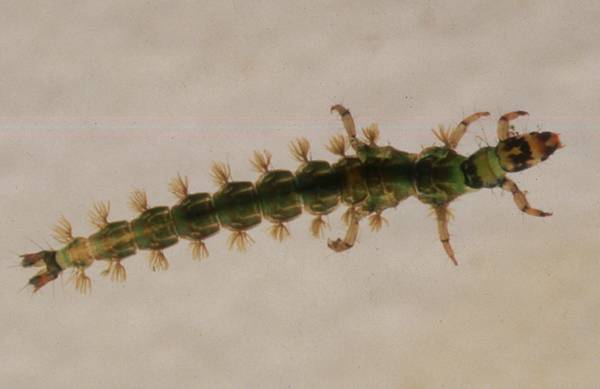Rhyacophila dorsalis - Sandfly
Phylum: Arthropoda - Class: Insecta - Order: Trichoptera - Family: Rhyacophilidae

The sandfly is one of the small number of sedge flies whose larvae are free swimming rather than case builders. There are several very similar species, and anglers give them all the same common name, the Sandfly.

The larvae live under stones in fast and medium-paced rivers; they forage for food as dusk descends but are not generally available for trout to prey upon except when their pupae are beginning to 'hatch' (to leave the pupal shuck), when, particularly on breezy days, they may be seen fluttering on the surface before gaining full control of their wings.
Winged adult
The adults, of medium size, appear in autumn and are mainly seen flying in the evening, but as they rarely occur in large numbers anglers find that a specific imitation of this sedge fly is not really necessary. Any medium-sized artificial sedge pattern, such as a Red Sedge, seems to do the trick.
References
O'Reilly, Pat. (1997; 8th reprint 2010) Matching the Hatch. Shrewsbury: Quiller Publishing.
Barnard, P & Ross, E. (2007) A Guide to the adult caddisflies or sedge flies (Trichoptera). Taunton: Field Studies Council.
Wallace, I. (2006) Simple Key to Caddis Larvae. Taunton: Field Studies Council.
Wallace, I.D., Wallace, B., & Philipson, G.M. (2003) Keys to the Case-bearing Caddis Larvae of Britain and Ireland. Ambleside: Freshwater Biological Association.
Macan, T.T. (1973) A Key to the Adults of the British Trichoptera. Ambleside: Freshwater Biological Association.
Excited at the prospect of flyfishing? So are we, and we're pretty sure you would find the Winding River Mystery trilogy of action-packed thrillers gripping reading too. Dead Drift, Dead Cert, and Dead End are Pat O'Reilly's latest river-and-flyfishing based novels, and now they are available in ebook format. Full details on our website here...
Buy each book for just £4.96 on Amazon...
Please Help Us: If you have found this information interesting and useful, please consider helping to keep First Nature online by making a small donation towards the web hosting and internet costs.
Any donations over and above the essential running costs will help support the conservation work of Plantlife, the Rivers Trust and charitable botanic gardens - as do author royalties and publisher proceeds from books by Pat and Sue.
